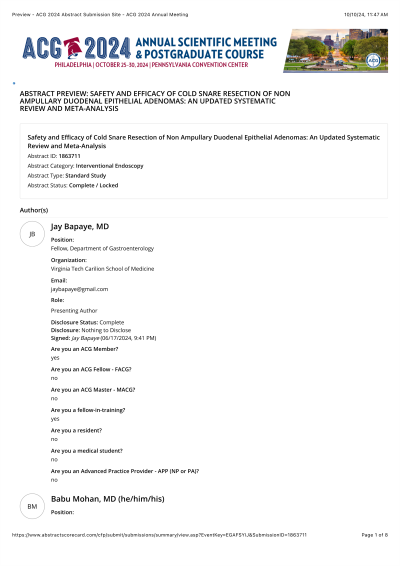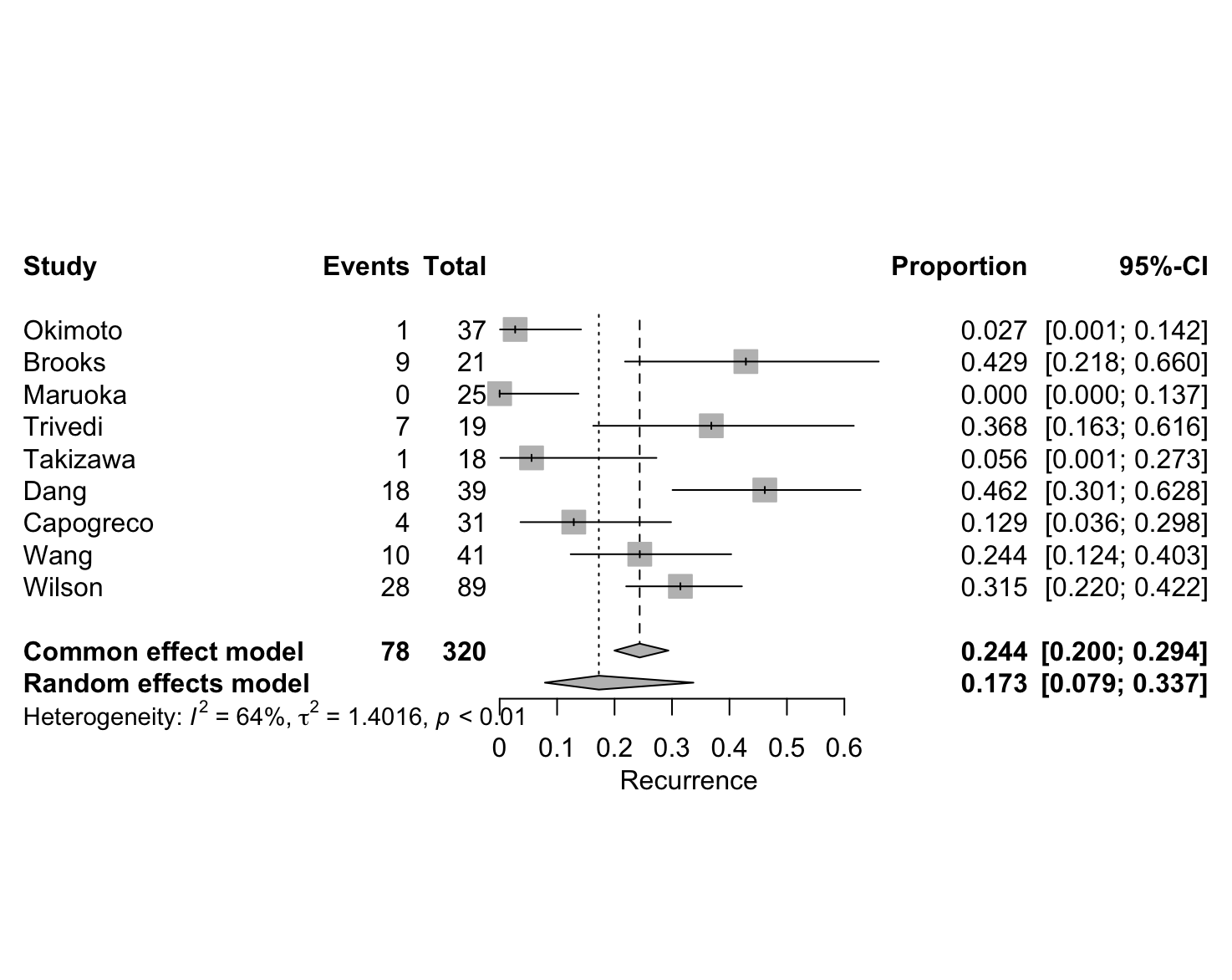Monday Poster Session
Category: Interventional Endoscopy
P2755 - Safety and Efficacy of Cold Snare Resection of Non Ampullary Duodenal Epithelial Adenomas: An Updated Systematic Review and Meta-Analysis
Monday, October 28, 2024
10:30 AM - 4:00 PM ET
Location: Exhibit Hall E


Jay Bapaye, MD
Virginia Tech Carilion School of Medicine
Roanoke, VA
Presenting Author(s)
Jay Bapaye, MD1, Babu Mohan, MD2, Subhash Garikipati, MD1, Dushyant S. Dahiya, MD3, Chengu Niu, MD4, Reid Wasserman, DO1, Klaus Monkemuller, MD, PhD1, Varun Kesar, MD1
1Virginia Tech Carilion School of Medicine, Roanoke, VA; 2Orlando Gastroenterology PA, Orlando, FL; 3The University of Kansas School of Medicine, Kansas City, KS; 4Rochester General Hospital, Rochester, NY
Introduction: Cautery-based resection has been associated with delayed adverse events after endoscopic resection of lesions. Cold-snare techniques have been increasingly used in the resection of gastrointestinal lesions to minimize these adverse events. The literature on use of cold resection techniques for duodenal adenomas is limited. To amplify current evidence, we conducted a systematic review and meta-analysis evaluating the safety and efficacy of cold snare resection (CSR) of non-ampullary duodenal adenomas.
Methods: Multiple databases were searched through June 2024 for studies reporting outcomes after the use of CSR for duodenal non-ampullary adenoma resection. Meta-analysis with a random effects model was performed to determine the pooled proportions and odds ratios (ORs) of outcomes of interest.
Results: We included 11 studies studying 407 patients and 758 lesions ranging from 4-70 mm that underwent CSR. Pooled rates of immediate and delayed bleeding were 2.2% [95% CI 0.9, 5.3] and 1% [95% CI 0.4, 2.5] respectively. There were 2 intraprocedural perforations and 0 delayed perforations among patients undergoing CSR. ORs of CSR vs hot-snare-resection for immediate bleeding were comparable at 0.57 [95% CI 0.08, 3.34] but those for delayed bleeding were significantly lower with CSR at 0.11 [95% CI 0.015, 0.79]. Adenoma recurrence rates were 2.5% [95% CI 0.6, 9.4] for adenomas under 10 mm and 29% [95% CI 20.4, 39.4] for those over 10 mm. Meta-regression analysis confirmed a significant association between increased adenoma size and rate of recurrence, P < 0.05. Endoscopic adenoma eradication was achieved in 98.8% [95% CI 86.6, 99.9] patients after CSR.
Discussion: CSR is associated with a good safety profile and acceptable efficacy for the resection of non-ampullary duodenal adenomas. Surveillance endoscopy is crucial especially after the resection of large adenomas due to the considerable recurrence rate.

Note: The table for this abstract can be viewed in the ePoster Gallery section of the ACG 2024 ePoster Site or in The American Journal of Gastroenterology's abstract supplement issue, both of which will be available starting October 27, 2024.
Disclosures:
Jay Bapaye, MD1, Babu Mohan, MD2, Subhash Garikipati, MD1, Dushyant S. Dahiya, MD3, Chengu Niu, MD4, Reid Wasserman, DO1, Klaus Monkemuller, MD, PhD1, Varun Kesar, MD1. P2755 - Safety and Efficacy of Cold Snare Resection of Non Ampullary Duodenal Epithelial Adenomas: An Updated Systematic Review and Meta-Analysis, ACG 2024 Annual Scientific Meeting Abstracts. Philadelphia, PA: American College of Gastroenterology.
1Virginia Tech Carilion School of Medicine, Roanoke, VA; 2Orlando Gastroenterology PA, Orlando, FL; 3The University of Kansas School of Medicine, Kansas City, KS; 4Rochester General Hospital, Rochester, NY
Introduction: Cautery-based resection has been associated with delayed adverse events after endoscopic resection of lesions. Cold-snare techniques have been increasingly used in the resection of gastrointestinal lesions to minimize these adverse events. The literature on use of cold resection techniques for duodenal adenomas is limited. To amplify current evidence, we conducted a systematic review and meta-analysis evaluating the safety and efficacy of cold snare resection (CSR) of non-ampullary duodenal adenomas.
Methods: Multiple databases were searched through June 2024 for studies reporting outcomes after the use of CSR for duodenal non-ampullary adenoma resection. Meta-analysis with a random effects model was performed to determine the pooled proportions and odds ratios (ORs) of outcomes of interest.
Results: We included 11 studies studying 407 patients and 758 lesions ranging from 4-70 mm that underwent CSR. Pooled rates of immediate and delayed bleeding were 2.2% [95% CI 0.9, 5.3] and 1% [95% CI 0.4, 2.5] respectively. There were 2 intraprocedural perforations and 0 delayed perforations among patients undergoing CSR. ORs of CSR vs hot-snare-resection for immediate bleeding were comparable at 0.57 [95% CI 0.08, 3.34] but those for delayed bleeding were significantly lower with CSR at 0.11 [95% CI 0.015, 0.79]. Adenoma recurrence rates were 2.5% [95% CI 0.6, 9.4] for adenomas under 10 mm and 29% [95% CI 20.4, 39.4] for those over 10 mm. Meta-regression analysis confirmed a significant association between increased adenoma size and rate of recurrence, P < 0.05. Endoscopic adenoma eradication was achieved in 98.8% [95% CI 86.6, 99.9] patients after CSR.
Discussion: CSR is associated with a good safety profile and acceptable efficacy for the resection of non-ampullary duodenal adenomas. Surveillance endoscopy is crucial especially after the resection of large adenomas due to the considerable recurrence rate.

Figure: Pooled proportion of recurrent adenoma at surveillance endoscopy
Note: The table for this abstract can be viewed in the ePoster Gallery section of the ACG 2024 ePoster Site or in The American Journal of Gastroenterology's abstract supplement issue, both of which will be available starting October 27, 2024.
Disclosures:
Jay Bapaye indicated no relevant financial relationships.
Babu Mohan indicated no relevant financial relationships.
Subhash Garikipati indicated no relevant financial relationships.
Dushyant Dahiya indicated no relevant financial relationships.
Chengu Niu indicated no relevant financial relationships.
Reid Wasserman indicated no relevant financial relationships.
Klaus Monkemuller indicated no relevant financial relationships.
Varun Kesar indicated no relevant financial relationships.
Jay Bapaye, MD1, Babu Mohan, MD2, Subhash Garikipati, MD1, Dushyant S. Dahiya, MD3, Chengu Niu, MD4, Reid Wasserman, DO1, Klaus Monkemuller, MD, PhD1, Varun Kesar, MD1. P2755 - Safety and Efficacy of Cold Snare Resection of Non Ampullary Duodenal Epithelial Adenomas: An Updated Systematic Review and Meta-Analysis, ACG 2024 Annual Scientific Meeting Abstracts. Philadelphia, PA: American College of Gastroenterology.
